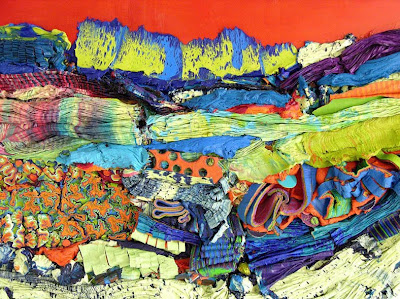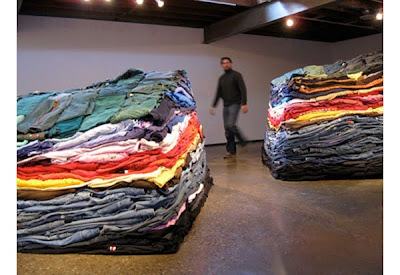 It's almost ironic that I went to see this show at the Halsey yesterday... just after all my talk about sculptural wall reliefs. Leslie Wayne's 3-dimensional paintings are a perfect example of the other types of reliefs that I mentioned. They take painting to another level, making the canvas (or panel, in her case) a home for material exploration, a base off of which her thick and gloopy paints are built upon one another by a means that is much more sculptural than is painterly. Yet they are paintings... in every sense of the word.
It's almost ironic that I went to see this show at the Halsey yesterday... just after all my talk about sculptural wall reliefs. Leslie Wayne's 3-dimensional paintings are a perfect example of the other types of reliefs that I mentioned. They take painting to another level, making the canvas (or panel, in her case) a home for material exploration, a base off of which her thick and gloopy paints are built upon one another by a means that is much more sculptural than is painterly. Yet they are paintings... in every sense of the word.These thick, layered works are composed solely of oil paint... lots of oil paint. In order to create such mind-boggling texture, Leslie Wayne manipulates the properties of paint by scraping, pulling, bunching, and folding the material. She describes herself as a "process painter," explaining "I may begin with a set of conditions, like a shaped panel for example, but then I take my cues from the working process." The exhibition includes a film revealing Leslie's process.
See the video HERE Paintings of various shapes and sizes make up Leslie Wayne's solo exhibition in the spacious Halsey Institute of Contemporary Art. The ones that appeal to me most are those that are narrow and vertical (seen above). I enjoy the way the layers are piled atop of each other, thicker and heavier towards the bottom as if they are being squished by the weight above. These demonstrate Wayne's references to landscape in a manner akin to my professor, Jarod Charzewki's piled clothing installations (seen below).
Paintings of various shapes and sizes make up Leslie Wayne's solo exhibition in the spacious Halsey Institute of Contemporary Art. The ones that appeal to me most are those that are narrow and vertical (seen above). I enjoy the way the layers are piled atop of each other, thicker and heavier towards the bottom as if they are being squished by the weight above. These demonstrate Wayne's references to landscape in a manner akin to my professor, Jarod Charzewki's piled clothing installations (seen below).
Of all the pieces in the show, there was one that particularly stood out to me. It was the only one in which the paint stood alone, without a panel. This painting, seen below, is taking Wayne's reliefs into another realm. By removing the surface onto which the paint is ordinarily applied, the paint itself becomes the object. This idea of "art and objecthood" is something I am interested in exploring in my own work. More on that another day.
will be on display at the Halsey Institute of Contemporary Art until March 12th...
don't miss it!
don't miss it!





























